Back to: BIOLOGY SS2
Welcome to Class !!
We are eager to have you join us !!
In today’s Biology class, We will be learning about the Digestive System. We hope you enjoy the class!
CONTENT
INVERTEBRATES
- Feeding in Hydra
- Digestion in Planaria
- Digestion in Earthworm
- Digestion in insects (Grasshopper)
VERTEBRATES
- Digestion in Birds
- Digestion in Rabbits
FEEDING IN HYDRA
Hydra feeds on small aquatic organisms e.g. crustaceans. It captures its food through its structure called nematocysts found on its tentacles. The food is then passed into the mouth while the digestive enzymes are secreted into the enteron by the gland cells. The digestion is extracellular and the digested food is absorbed into the body while the undigested food is sent back into the enteron and released through the mouth. The digestion here is therefore intracellular and extracellular.
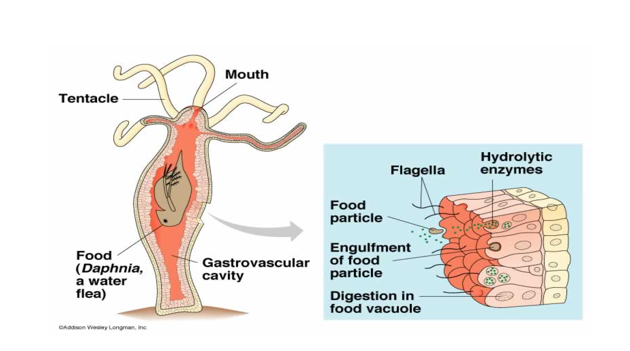
DIGESTION IN FLATWORM [TAPEWORM & PLANARIA]
Tapeworm is a parasitic worm which has no alimentary canal; it feeds on digested food of the host. However, the planarian is a free-living flatworm which feeds on small animals. Planaria has a simple alimentary canal with one opening i.e. the mouth present in the ventral part of its body cavity. The pharynx of the planarian can be extended out of the mouth during feeding. The pumping action of the pharynx sucks in pieces of food which enter the pharynx and move into the small intestine. Digestion is partly extracellular and partly intracellular. The branched intestine enables the digested food to diffuse to all parts of the body while undigested food is egested through the mouth.
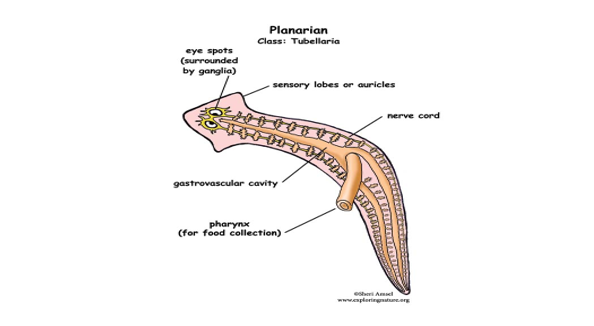
EVALUATION
- Compare feeding in hydra with feeding in planaria
- Explain extracellular digestion.
DIGESTION IN EARTHWORM
The alimentary canal of the earthworm is a tube with two openings:
- The mouth through which the food enters
- The anus through which the undigested food leaves the body
The alimentary canal of the earthworm has the following parts:
- Mouth and thin-walled buccal cavity for food ingestion
- A muscular thin-walled pharynx which secretes mucus to lubricate food particles
- A narrow tubular thin-walled oesophagus
- A thin-walled crop for storing food
- A thin-walled muscular gizzard where food is ground against small stones to break it up.
- A long straight intestine in which extracellular digestion occurs.
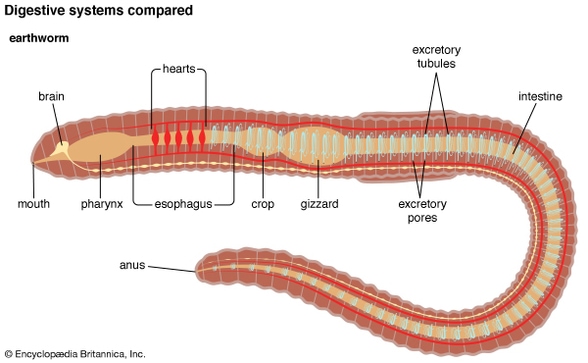
MECHANISM OF DIGESTION IN EARTHWORM
The prostomium is the mouth of the earthworm. Since it has no jaws or teeth, the earthworm uses its muscular pharynx to suck in soil containing food. The food particles and soil go through a long oesophagus into a round organ called a crop. The crop stores the food temporarily. Then it is forced into a very muscular organ called the gizzard. The gizzard contracts and expands, causing grains of sand and food to rub together. In this way, the food is ground up. Food is digested in the intestine, which stretches from segment nineteen to the end of the worm. Here enzymes chemically break down the food. Then the digested food is absorbed by the blood circulating through the intestinal walls. The earthworm’s digestive system can be thought of as a tube within a tube.
The complicated organs of the digestive system take up most of the anterior half of the earthworm’s body. The earthworm ingests large amounts of soil, which has organic matter in it. The useless inorganic matter goes through the worm with no change. This is often left on the surface of the ground in the form of castings. As the earthworms feed, they loosen the soil, making it easier for air and water to enter. Their wastes also add to soil fertility. If there were no earthworms, the soil could not support crops, grasses, and other plants.
EVALUATION
- Mention all the parts of earthworm involved in digestion.
- Explain how castings are formed in the earthworm.
DIGESTION IN INSECTS
The alimentary canals of insects consist of three major parts:
- The foregut [mouth, pharynx, oesophagus crop, gizzard]
- Mid gut [stomach]
- Hind gut [intestine, ileum, colon, rectum, anus]
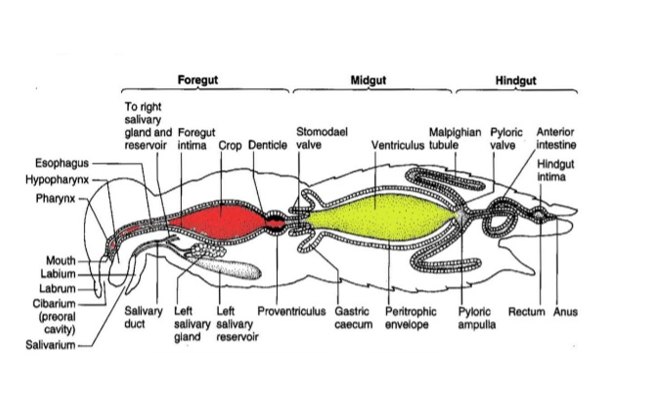
Insects such as grasshoppers feed on leaves. They use their mouthparts to cut and crush the leaves. Saliva is introduced or poured into the leaves from the salivary gland. The saliva helps to soften the leaves and the chewed food is in the crop and broken up further into small pieces.
The foregut and the midgut secrete enzymes rich juice into the midgut where digestion and absorption occurs.
The hindgut is for water absorption. Only solid faeces pellets are egested from the anus after the food waste has been collected through the malpighian tubules joining the mid and hindgut.
DIGESTION IN BIRD
Birds do not have teeth but horny beak which they use for feeding. In many birds, the feet also show adaptation for feeding.
The alimentary canal of the bird consists of the following:
- Oesophagus 2. Crop 3.Proventriculus 4. Gizzard 5. Small intestine 6. Caeca 7. Cloaca
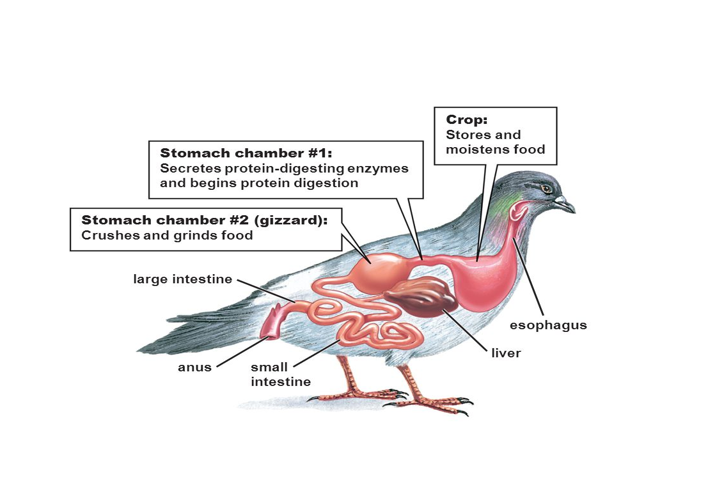
MECHANISM OF DIGESTION IN BIRDS
The bird swallows their food whole and store in the crop. In the crop, it is softened by secretion from the wall of the crop. It is then through the proventriculus to the gizzard where gastric juice churns the food and breaks it up into smaller units. This is preceded by the grinding action of the muscles of the gizzard [a strong muscular bag]. Small stones in the gizzard also assists in the grinding of the food. The digestion is completed in the small intestine by the action of intestinal and pancreatic juice. The absorption also occurs here and the solid waste passed through the anus into the cloaca.
EVALUATION
- State the three parts that make up the digestive system of insects.
- Describe the mechanism of digestion in birds.
We have come to the end of this class. We do hope you enjoyed the class?
Should you have any further question, feel free to ask in the comment section below and trust us to respond as soon as possible.
In our next class, we will continue learning about the Digestive System. We are very much eager to meet you there.
